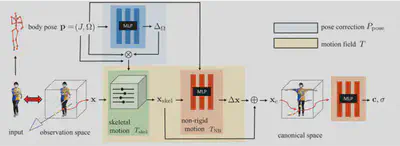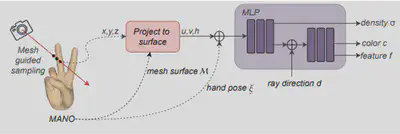Implicit Hand Reconstruction
Aleksei Zhuravlev, Dr. Danda Pani Paudel and Dr. Thomas Probst
 |  |
Abstract
This work addresses the problem of reconstructing an animatable avatar of a human hand from a collection of images of a user performing a sequence of gestures. Our model can capture accurate hand shape and appearance and generalize to various hand subjects. For a 3D point, we can apply two types of warping: zero-pose canonical space and UV space. The warped coordinates are then passed to a NeRF which outputs the expected color and density. We demonstrate that our model can accurately reconstruct a dynamic hand from monocular or multi-view sequences, achieving high visual quality on Interhand2.6m dataset.
Method


- Warping of 3D points to zero pose canonical space - adapted the approach of HumanNeRF to the hand setting instead of full body
- Warping of 3D points to UV space (texture coordinates + distance to the mesh), based on LiveHand - developed from scratch without using C++ CUDA kernels
- Introduced perceptual loss (LPIPS) to enhance the visual quality; improved PSNR score by 14% over MSE-only loss
Results
 |  |
Single view multi-pose sequence
